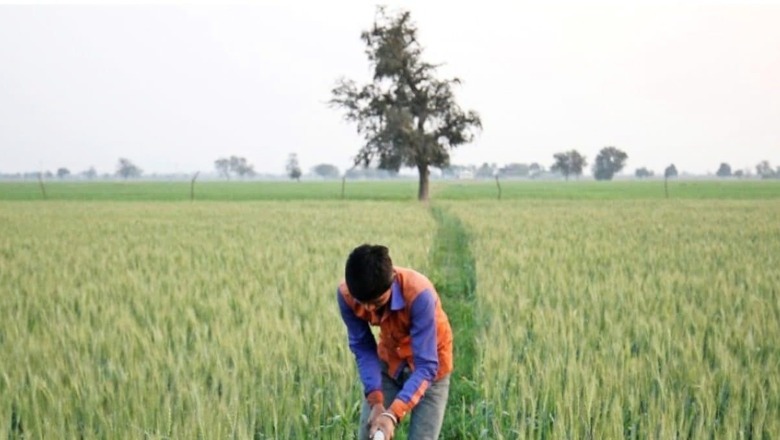
views
The agriculture sector is highly vulnerable to climate change as it is a big challenge for the agrarian economy. Food-bowl Punjab and Haryana farmers’ fetish for unsustainable big cereal wheat this time has begun to hurt, as returns diminish due to climate challenges. The climate challenge farmers faced this time was erratic rainfall at the end of March, when crops were ready to harvest, which was likely to affect the yield significantly. In the case of Punjab, the initial deliberation by the agriculture department has indicated that at least 40 percent of 35 lakh hectares of wheat sown is impacted by rain, winds, and hailstorms. The serious challenges from climate change-induced impacts of erratic rainfall and heat waves are not just a threat to our food security and nutrition but to the livelihood of 45 percent of the country’s population who depend on farming. It has an impact on their income to fulfill their basic needs and also on their crop loan cycle, to return on time to get fresh lending and to invest back into their farms.
Policymakers, agri-scientists and farmers must come together to confront the challenge of climate change. Various climate change policies are established at international, national and state levels to address the impacts of climate change. Traditionally, the focus of such policies remained on mitigation instead of adaptation measures despite urgent requirements for adaptation strategies being emphasised. Adaptation actions are needed to respond to climate change as these actions help to reduce vulnerabilities. There is an urgent need to enable farmers to survive climate change.
Overuse of resources like water, soil, fertilisers, and pesticides to boost yield results in greenhouse gas (GHG) emissions which invite climate change. Take the example of Punjab. After the implementation of the Food Security Act, the country is once again looking toward Punjab, but Punjab farmers need to conserve soil and water management along with adopting diversification in agriculture. The state has never been able to implement an agenda of crop diversification.
The Punjab government, in FY 2023-24 budget, has made the provision of Rs 1000 core for crop diversification. To support it, the action plan and adaptation to climate change are also equally important. Therefore, a state-level Climate Change Management Commission (CCMC) should be established, dedicated to connecting a sustainable solution to climate-resilient farming. In state agriculture universities, specially trained climate change research professionals with specialisation in different areas of knowledge domain and expertise are needed. Public-Private Partnerships are also required to manage climatic impacts and to focus not only on mitigation technologies but also adaptation.
Why are the Funds Dwindling for Action Plan?
The National Mission on Strategic Knowledge for Climate Change (NMSKCC) seeks to build a vibrant and dynamic knowledge system that would inform and support action for responding effectively to the objective of ecologically sustainable development, making agriculture climate resilient by promoting location-specific integrated farming systems. The National Adaptation Fund for Climate Change (NAFCC) was also established in 2015 to meet the cost of adaptation to climate change for the states. But why are the funds dwindling to address this serious challenge causing rampant destruction? The grants released under NAFCC fell from Rs 350 crore in 2015-16 to Rs 27.76 crore in 2022-23, while the sub-committee of the Ministry of Finance has estimated that the cumulative expenditure for adapting to climate change would amount to Rs 85.60 lakh crore by the year 2030.
Research and Development (R&D) is the bedrock of climate resistance agriculture but the minuscule investments in R&D in India impede the ability of science and technology research to tackle multiple challenges in the agriculture sector. As per the Indian Council of Agriculture Research (ICAR), around 85 percent of their budget goes towards salaries and other administrative/establishment expenditures, with little left for research. The same is with state agriculture universities facing a financial crunch for R&D work. The total R&D expenditure in India, as a percentage of agricultural GDP, has been stagnant at 0.3 to 0.5 percent in the last two decades. It is much lower than in the US (2.8 percent), China (2.1 percent), South Korea (4.3 percent), and Israel (4.2 percent).
For a country that experiences almost extreme weather every year, adaptation and resilience building must be a priority. India needs more granular risk analysis that can help target appropriate adaptation action locally while making new infrastructure climate resilient and strengthening early warning systems. An analysis by the Council on Energy, Environment, and Water found that the frequency and intensity of extreme climate events have increased by almost 200 percent since 2005 and three out of four Indian districts are facing extreme climate change. Expert analyst estimates show that climate change might reduce global agriculture productivity by 17 percent by 2030. According to a study by the World Meteorological Organisation, India is estimated to have suffered an average annual loss of more than Rs 6 lakh crore from climate-induced changes.
The Way Forward
To face the risks in agriculture associated with climate change, adaptation is the key factor to address the negative impacts of climate change. Farmers should start promoting sustainable integrated agriculture practices that could enable them to reduce the vulnerabilities of climate change by higher crop diversity from staples to high-value crops, fruit, and vegetables. Integrated farming with the inclusion of dairy, poultry, beekeeping, fisheries, and mushroom cultivation can give additional high-energy food without affecting the production of food grains.
There are four sustainable ways farmers can produce more food and adapt to climate change at the same time-
- Farmers need hand-holding in the early phases. Support them for knowledge exchange with skill-intensive practices.
- Support technology innovation and adaptation to minimise the vulnerabilities of climate change with sustainable agriculture practices.
- Instead of input-based subsidies for fertiliser and power, incentivising outcome-based support could encourage innovation among farmers and allow the adoption of alternative approaches.
- Enhanced research and development for impact studies compared with conventional farming across agro-climatic zones. The rigour of regular comparisons of outcomes amid climate change is important for safeguarding farm decent income, nutrition, and food security.
The writer is Vice-chairman of Sonalika group, vice-chairman (Cabinet minister rank) of Punjab Economic Policy and Planning Board. Views expressed are personal.
Read all the Latest Opinions here















Comments
0 comment